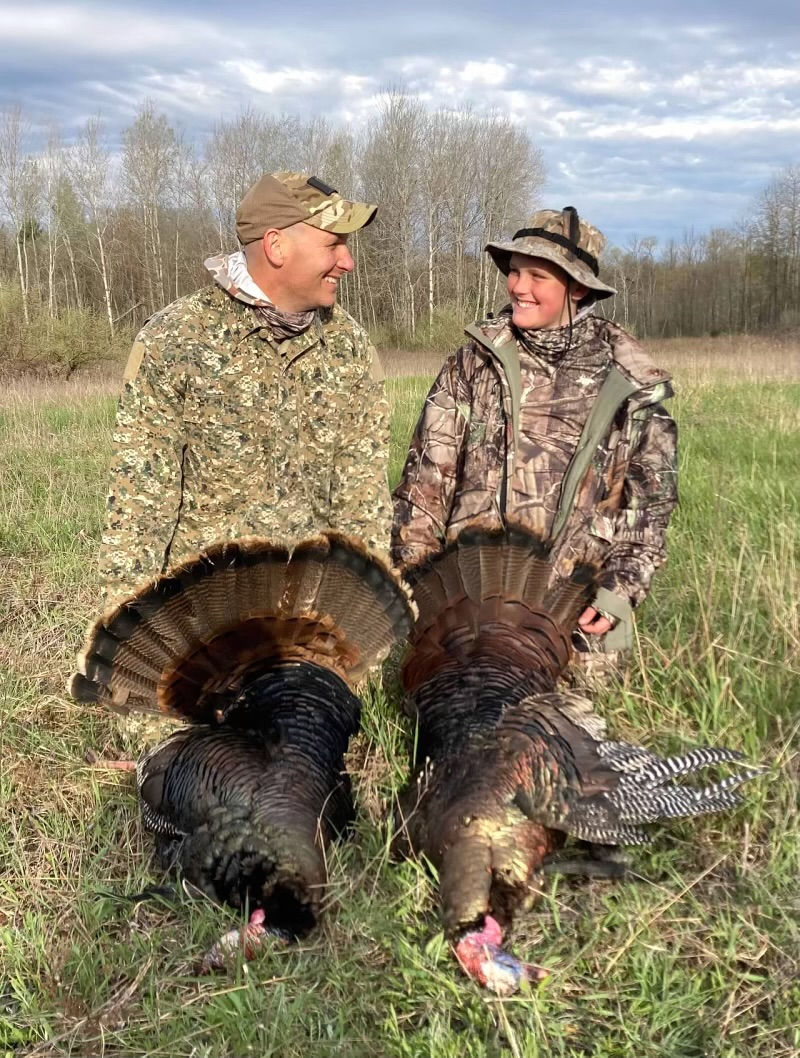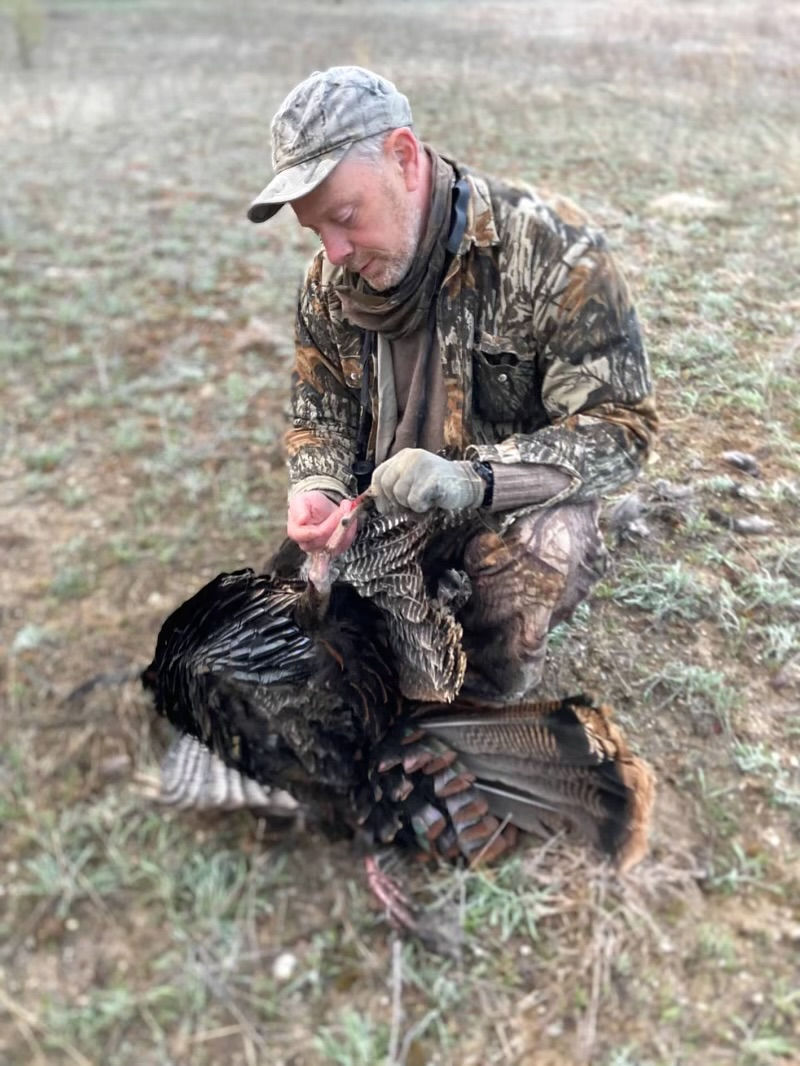Talking Turkey Part 2 – Sage Wisdom from Chris "Boom" Smith
- Chris Smith
- Mar 29, 2023
- 6 min read
Updated: Mar 7, 2024

Well before the first gobble on the opener, most successful turkey hunters have done the nuts and bolts of what it takes to enjoy wild turkey at Thanksgiving: scouting. If the prep work is performed with care and patience, the hunts themselves are much more predictable and enjoyable. Sort of like bowel prep — just think how a colonoscopy would go without the magic pills the day before?
Locating turkeys and learning their daily patterns can provide even the most novice hunter a fighting chance the next morning. Thankfully, unlike deer, turkeys are civilized and sleep at night, flying down before sunrise from their roost trees to feed and breed, typically in the open, which makes them visible. With a home range less than a mile, a little windshield time and patience will confirm if birds are in the area. Once I’ve checked this box and can hunt the property — either private or public — I enter the next phase of scouting: more scouting.
Some fellas only need to hear a distant gobble to seal the deal, but for beginners, the more intel, the better. Case in point. Two years ago, my buddy Ozzy had access to a bunch of birds on some property too far away for a scouting mission. The next morning, despite my best calling efforts, the birds wanted to head the other direction to a strutting and feeding area. So last year, we set up along that route and called in a beauty bird for Ozzy’s son, Wil, his first, all because we knew where the birds wanted to go.

But it’s easy to “over-scout,” starting with a couple of huge no-nos. First and most important, calling: don’t. Resist the urge to call to locate turkeys — it educates birds you might potentially hunt. Gobblers — especially the old ones — can pinpoint sound, pitch, and cadence to within a foot, and thankfully so. It’s what allows us to call them in for a close, humane shot. If we overplay our hand, though, we might actually call them in and get busted. Instead, listen. I probably hear more birds than I see. Sitting for 15 minutes to a half hour, I listen for males gobbling and hens calling, especially when males “shock” gobble to other noises, like crows, owls, cranes, or geese. Any time I hear these other animals, I immediately wait a few seconds for a gobble.
If you’re lucky and spot a flock of birds and can observe them through binoculars undetected, take note of where they’re roosted, when they fly down, how many are in the flock, hen to gobbler ratio, jake to tom ratio, what path they take to the first strutting/breeding area, where they go between hours 8am and 10am, where they spend the early afternoon hours, and when they return to the roost area. While I’m successful occasionally off the roost, I kill more gobblers mid-morning and toward the end of the day, so I’m very particular about where birds are at these times. Turkeys will stick to a similar pattern unless spooked, or until nesting hens cause gobblers to start traveling for another girlfriend.

So while scouting, the biggest thing is to not get busted. If you have to sneak around your desired hunting spot to know where birds are traveling, remember to camo up, and plan to stay a while if birds show up and you can’t leave without spooking them.
Many old-timers talk about “roosting” a bird to maximize chances the next morning — locating the area or exact tree he’s sleeping in. That’s great advice, though unnecessary. But if you must, do it quietly, by listening and looking, not trying to get them to gobble. Owl hoots and crow calls are mediocre locators, and while they may or may not render a precious gobble, you risk tipping your location, especially if you make noise exiting the woods, or it’s quiet enough to hear your truck door slam, engine start, etc. Watch from a distance, locate a tom in the area, then sneak out of there. Generally speaking, in our neck of the woods, a gobbler is in his “roost” area around 7-8pm. If I see him, I make tracks out of there.
I don’t get too excited (other than the constant turkey mania I wake up with this time of year) until a week before the season. To be sure, when late winter’s storms and icy weather pour salt on my cabin fever, I take a few preliminary hikes to see what’s lurking. But a couple of weeks away means it’s time to bust out the camo and binoculars and find those birds.

The Rest of the Hunt:
Camo: Thankfully, there’s elevendybillion varieties of camouflage on the market, so take your pick, just don’t hunt in blue jeans and an Eddy Van Halen tee shirt; I prefer soft and quiet over waterproof, and camo everything, from face to hands, all the way down to boots.
Calls: I’m a huge believer in mouth calls, specifically diaphragms, though friction calls like boxes, slates, and push-buttons work great. Find your favorite and practice, preferably not in the house so your loved ones don’t shoot you before opening day. While a hen turkey makes a myriad of calls, learning a basic yelp and cluck will lure most gobblers within range. Advanced cutting and purring will make even the wariest of toms weak-kneed. Youtube provides all the calling tutorials one would need to learn to call effectively.
Guns and loads: Theories abound, but any legal gun and load will kill a gobbler, though most hunters prefer a 12 gauge. Common wisdom and turkey toughness suggest a tight choke to concentrate pellets for the preferred head and neck shot. But if a bird is on top of you, a tight pattern won’t be much bigger than the bird’s head, creating the chance for a gut-wrenching miss at close distance. Double guns with two chokes have an advantage here. I prefer one moderately tight and one open, given we shoot most of our birds inside 20 yards, and sometimes inside ten.
Modern magnum turkey loads work fine, though pack quite a punch to the shooter’s shoulder, especially young shooters. Shot size can’t be larger than #4, but I prefer 5s and 6s. Buy a box of shells and pattern test at the distances you intend to shoot from, and from the position you typically shoot (sitting, kneeling, etc.). Remember, it’s ethical to hold off on a marginal shot at long distance to avoid crippling a bird, even if it means not getting a turkey that season.

Decoys: They’re more realistic than ever, and one or two are often all that’s needed. There are jakes, full-strutting toms, hens in breeding position, feeders, you name it. A common mistake is placing them too far away. Gobblers often stop short to strut and wait for the hen to come to them, rendering a bird out of range even though he’s not spooked. Fifteen yards away is my max for decoys, keeping in mind that some birds are decoy shy, so if they seem nervous, remove the fakes and go with calling only.
Binos: Binoculars stay around my neck during every hunt. Birds can hear our calling over 500 yards away, but differentiating males from females or judging beard length is tough with the naked eye.
Shooting: Practice shooting your turkey gun from the sitting or kneeling position you’ll most likely be twisted into. It’s much different than normal “wingshooting,” and easy to shoot over a gobbler’s head, even if he’s close. I draw a turkey head on a large piece of paper as a target, or purchase them at a sporting goods store. While conventional wisdom suggests head shots, your intended target should be the base of the neck, where the dark feathers meet the fleshy red parts because not only will a neck shot kill a turkey, but a substantial portion of a shotgun’s pattern will be slightly above the target, meaning many pellets will still go into the head. Also, in the excitement of a shot, it’s easy to raise the gun slightly and shoot high. Holding at the base of the neck compensates for that.
Last, and most importantly, pay attention. Every hunt teaches us something to apply to the next one. Be where the birds want to be “before” they get there, and don’t expect to kill a gobbler five minutes after he flies down. Be patient, knowing that if they leave the area, they’re really not that far, and can return any time, especially when hens disappear mid-morning, making gobblers more susceptible to calling. Don't give up, but don’t pull out all the stops unless it’s the last day.

About: Christopher Smith is a wildlife artist and freelance author from Suttons Bay, Michigan, where he lives with his wife, two teenagers, and two obnoxious Labs. He specializes in dogs and wildlife scenes for pet owners and wildlife lovers across the country. Chris has illustrated more than two-dozen hunting and fishing books. For over twenty-five years, he has been a freelance author and illustrator for a variety of magazines such as Ducks Unlimited, Retriever Journal, The Pointing Dog Journal, Just Labs, Delta Waterfowl, Ruffed Grouse Society, Upland Almanac, and the Record-Eagle Scene, as well as a columnist for the Record Eagle newspaper, both based in Traverse City, Michigan. He is author and illustrator of Small Water Waterfowling and Field Guide to Upland Bird and Waterfowl Identification, and co-author of Waterfowling Horizons and the Lost Branch Sportsman’s Club series. A graduate of Lake Superior State University in Sault Ste. Marie, MI, he holds a B.S. in Fisheries and Wildlife Management. When not in his studio, he’s out conducting “field research” for another painting or article, although his wife might suggest he’d be out there anyway. Learn more here.

Comments